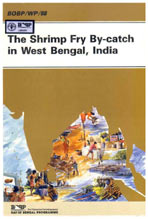
WORKING PAPERS - BOBP/WP/88
The Shrimp Fry By-catch in West Bengal, India
by
B. K. Banerjee & H.
Singh
Central Institute of Brackish water Aquaculture
MADRAS
 |
WORKING PAPERS - BOBP/WP/88 The Shrimp Fry By-catch in West Bengal, Indiaby |
|
Executing Agency: FOOD AND AGRICULTURE ORGANIZATION OF THE UNITED NATIONS Bay of Bengal Programme Madras, India, 1993 |
| The designations employed and the presentation of material in this publication do not imply the expression of any opinion whatsoever on the part of the Food and Agriculture Organization of the United Nations concerning the legal status of any country, territory, city or area or of its authorities, or concerning the delimitation of its frontiers or boundaries. |
All rights reserved. Reproduction and dissemination of material in this information product for educational or other non-commercial purposes are authorized without any prior written permission from the copyright holders provided the source is fully acknowledged. Reproduction of material in this information product for resale or other commercial purposes is prohibited without written permission of the copyright holders. Applications for such permission should be addressed to the Chief, Publishing and Multimedia Service, Information Division, FAO, Viale delle Terme di Caracalla, 00100 Rome, Italy or by email to [email protected]
© FAO 2004
|
Culture of tiger shrimp has gained momentum over the last decade in many parts of the world due to its high export value. It has become a major foreign exchange earner in India, where West Bengal is the largest culture centre. In West Bengal, the basic input of tiger shrimp fry is met from the wild, with a large number of the rural poor engaged in shrimp fry-catching and trading in the 24 Parganas (N and S) and Medinipur Districts. However, the destruction of by-catch captured during fry-collection has been causing concern. This working paper, based on work done from October 1990 to September 1991 gives an overall picture of the shrimp fry by-catch by assessing quantitatively the seasonal and spatial variations in the species composition. By-catch is 64-99.4 percent of the total fry caught. The fry by-catch destroyed over a period of one year is estimated at 62 million - 2592 million. The study was carried out by the Central Institute of Brackish water Aquaculture (CIBA) at its Research Centre in Kakdwip, West Bengal. It was sponsored by the Bay of Bengal Programme (BOBP) of the Food and Agriculture Organization (FAO). Two field biologists were engaged by BOBP for sampling and data collection at three centres and the project was implemented under the supervision of CIBA scientists. The authors acknowledge the contributions of the following : Dr K. Alagarswami, Director, CIBA. Madras, for his guidance and keen interest in the investigations; A.V.P. Rao, Principal Scientist, for monitoring the project and critically going through the manuscript; the field biologists, Rabi Sil and R.S. Halder, for collection of field data; and R.K. Chakraborti, Scientist (SG) for valuable suggestions. |
1. INTRODUCTION
2. OBJECTIVES
3. ASSESSMENT OF SHRIMP FRY BY-CATCH
3.1 Definition
3.2 Methodology
4. TRADITIONAL FARMING
5. SHRIMP FRY COLLECTION
5.1 Shootnet (behundi jal)
5.2 Dragnet
5.3 Barrier nets
5.4 Craft
5.5 Collection method in tidal creeks and canals
5.6 Identification and segregation of shrimp fry
5.7 Seed calendar and abundance
6. SEASONAL ABUNDANCE OF SHRIMP BY-CATCH
6.1 The species ratio and percentage contribution
7. THE FRY TRADE
8. DISCUSSION
9. CONCLUSION
10. RECOMMENDATIONS
10.1 Educating the fry collectors
10.2 Establishing a fry bank
10.3 Reducing stocking density of Penaeus monodon fry in Bheries
10.4 Using hatchery fry as stocking material
10.5 Transporting tiger shrimp fry
10.6 Supplementary recommendations
FIGURES
1. Map of the Hugli estuarine system showing shrimp fry by-catch collection centres
2. Shootnet operation from shore
3. Shootnet operation from a boat
4. Dragnet
5. Barrier net
REFERENCES
APPENDICES
List of species encountered in seed collection net
TABLES1. Physico-chemical parameters (average) at different centres.
2. Total fish and shrimp landings (t) from the Hugli-Matla estuary before and after tiger shrimp fry trade
3. Production of P. monodon fry (million) and average price (Rs/thousand fry) at different centres
4. Total catch of P. monodon fry and other species by fry-collectors at three different centres
5. Species-wise seasonal abundance (catch/net/day) of shrimp fry by-catch at Harwood Point (No. x 100)
6. Species-wise seasonal abundance (catch/net/day) of the shrimp fry by-catch at Najat (No. x 100)
7. Species-wise seasonal abundance (catch/net/day) of the shrimp fry by-catch of Ramnagar (No. x 100)
PUBLICATIONS OF THE BAY OF BENGAL PROGRAMME